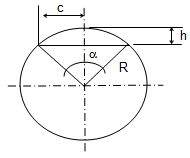buoyancy tank

Description
This spreadsheet is able to indetify the buoyancy force of buoyancy tank at certain immersion depth. Generally it is useful to give input for pipelay stress analysis.
Calculation Reference
Hydraulics
Design and Construction of Sanitary and Storm Sewers
To identify the buoyancy force of a buoyancy tank at a certain immersion depth, you need to determine the volume of the tank submerged at that depth and the density of the water in which it is submerged. Here are the steps to calculate the buoyancy force:
-
Determine the submerged volume (V_submerged) at the given immersion depth: Based on the geometry and dimensions of the buoyancy tank, calculate the volume of the submerged portion of the tank at the desired immersion depth.
-
Measure or estimate the density of the water (ρ_water): The density of water can vary based on its temperature and salinity. For freshwater, the density is approximately 1000 kg/m³, and for seawater, the density is approximately 1025 kg/m³. Use the appropriate density for your specific application.
-
Calculate the buoyancy force (F_B) using Archimedes' principle: The buoyancy force acting on the buoyancy tank can be calculated as:
F_B = ρ_water * V_submerged * g
where:
- ρ_water = density of water (kg/m³)
- V_submerged = volume of the submerged portion of the buoyancy tank (m³)
- g = acceleration due to gravity (approximately 9.81 m/s²)
By following these steps, you can calculate the buoyancy force acting on a buoyancy tank at a certain immersion depth. This information is essential for designing and operating buoyancy control systems, ensuring that the tank maintains its desired depth and stability in the water.
Calculation Preview
Full download access to any calculation is available to users with a paid or awarded subscription (XLC Pro).
Subscriptions are free to contributors to the site, alternatively they can be purchased.
Click here for information on subscriptions.

